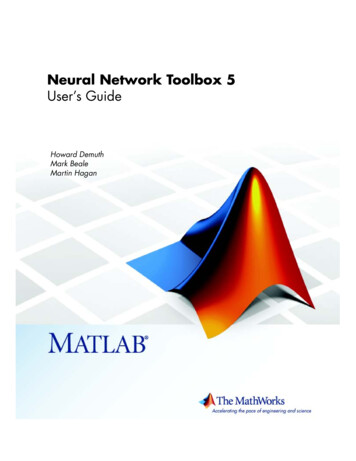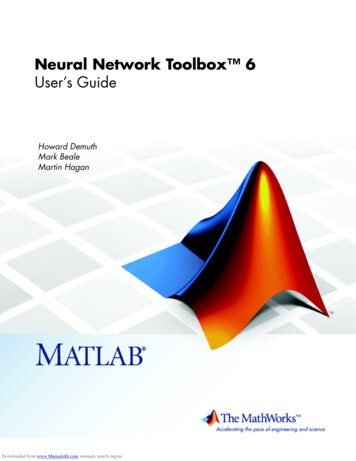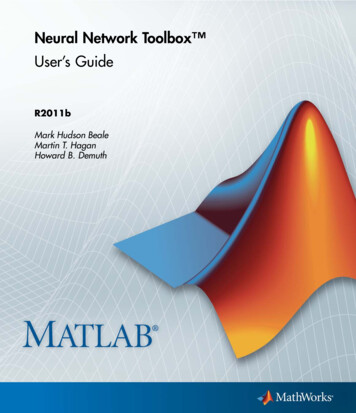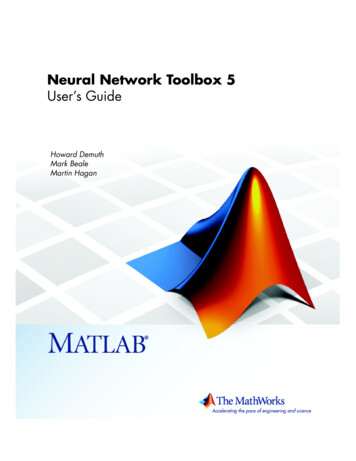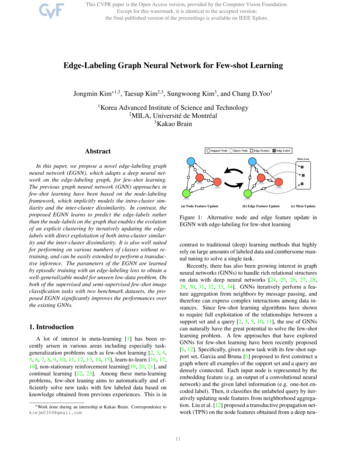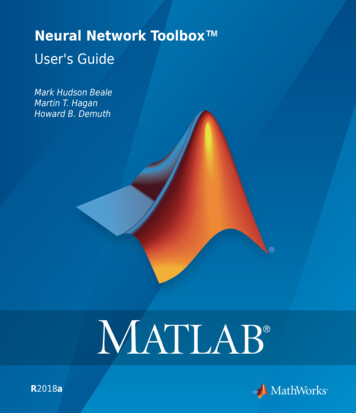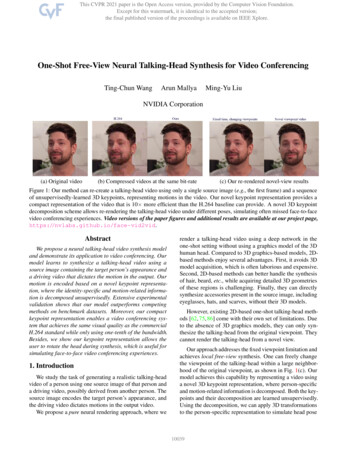
Transcription
One-Shot Free-View Neural Talking-Head Synthesis for Video ConferencingTing-Chun WangArun MallyaMing-Yu LiuNVIDIA Corporation(a) Original video(b) Compressed videos at the same bit-rate(c) Our re-rendered novel-view resultsFigure 1: Our method can re-create a talking-head video using only a single source image (e.g., the first frame) and a sequenceof unsupervisedly-learned 3D keypoints, representing motions in the video. Our novel keypoint representation provides acompact representation of the video that is 10ˆ more efficient than the H.264 baseline can provide. A novel 3D keypointdecomposition scheme allows re-rendering the talking-head video under different poses, simulating often missed face-to-facevideo conferencing experiences. Video versions of the paper figures and additional results are available at our project tWe propose a neural talking-head video synthesis modeland demonstrate its application to video conferencing. Ourmodel learns to synthesize a talking-head video using asource image containing the target person’s appearance anda driving video that dictates the motion in the output. Ourmotion is encoded based on a novel keypoint representation, where the identity-specific and motion-related information is decomposed unsupervisedly. Extensive experimentalvalidation shows that our model outperforms competingmethods on benchmark datasets. Moreover, our compactkeypoint representation enables a video conferencing system that achieves the same visual quality as the commercialH.264 standard while only using one-tenth of the bandwidth.Besides, we show our keypoint representation allows theuser to rotate the head during synthesis, which is useful forsimulating face-to-face video conferencing experiences.1. IntroductionWe study the task of generating a realistic talking-headvideo of a person using one source image of that person anda driving video, possibly derived from another person. Thesource image encodes the target person’s appearance, andthe driving video dictates motions in the output video.We propose a pure neural rendering approach, where werender a talking-head video using a deep network in theone-shot setting without using a graphics model of the 3Dhuman head. Compared to 3D graphics-based models, 2Dbased methods enjoy several advantages. First, it avoids 3Dmodel acquisition, which is often laborious and expensive.Second, 2D-based methods can better handle the synthesisof hair, beard, etc., while acquiring detailed 3D geometriesof these regions is challenging. Finally, they can directlysynthesize accessories present in the source image, includingeyeglasses, hats, and scarves, without their 3D models.However, existing 2D-based one-shot talking-head methods [62, 75, 86] come with their own set of limitations. Dueto the absence of 3D graphics models, they can only synthesize the talking-head from the original viewpoint. Theycannot render the talking-head from a novel view.Our approach addresses the fixed viewpoint limitation andachieves local free-view synthesis. One can freely changethe viewpoint of the talking-head within a large neighborhood of the original viewpoint, as shown in Fig. 1(c). Ourmodel achieves this capability by representing a video usinga novel 3D keypoint representation, where person-specificand motion-related information is decomposed. Both the keypoints and their decomposition are learned unsupervisedly.Using the decomposition, we can apply 3D transformationsto the person-specific representation to simulate head pose10039
2. Related WorksGANs. Since its introduction by Goodfellow et al. [21],GANs have shown promising results in various areas [44],such as unconditional image synthesis [21, 23, 31, 32, 33, 45,55], image translation [8, 12, 26, 28, 42, 43, 52, 61, 67, 77, 96,97], text-to-image translation [56, 84, 89], image processing [17, 18, 27, 35, 36, 37, 38, 40, 66, 72, 83, 88], and videosynthesis [2, 10, 34, 41, 46, 54, 57, 63, 75, 76, 95]. We focus onusing GANs to synthesize talking-head videos in this work.3D model-based talking-head synthesis. Works on transferring the facial motion of one person to another—facereenactment—can be divided into subject-dependent andsubject-agnostic models. Traditional 3D-based methods usually build a subject-dependent model, which can only synthesize one subject. Moreover, they focus on transferring theexpressions without the head movement [65, 69, 70, 71, 73].This line of works starts by collecting footage of the target person to be synthesized using an RGB or RGBD sensor [70, 71]. Then a 3D model of the target person is builtfor the face region [6]. At test time, the new expressions areused to drive the 3D model to generate the desired motions.More recent 3D model-based methods are able to perform subject-agnostic face synthesis [19, 20, 49, 51]. Whilethey can do an excellent job synthesizing the inner face region, they have a hard time generating realistic hair, teeth,accessories, etc. Due to the limitations, most modern facereenactment frameworks adopt the 2D approach. Anotherline of works [15, 68] focuses on controllable face generation, providing explicit control over the generated face fromExpressionHead poseUser-specifiedhead tructionSource imageDriving videochanges such as rotating the talking-head in the output video.Figure 2 gives an overview of our approach.We conduct extensive experimental validation with comparisons to state-of-the-art methods. We evaluate our methodon several talking-head synthesis tasks, including video reconstruction, motion transfer, and face redirection. We alsoshow how our approach can be used to reduce the bandwidthof video conferencing, which has become an important platform for social networking and remote collaborations. Bysending only the keypoint representation and reconstructingthe source video on the receiver side, we can achieve a 10xbandwidth reduction as compared to the commercial H.264standard without compromising the visual quality.Contribution 1. A novel one-shot neural talking-head synthesis approach, which achieves better visual quality thanstate-of-the-art methods on the benchmark datasets.Contribution 2. Local free-view control of the output video,without the need for a 3D graphics model. Our model allowschanging the viewpoint of the talking-head during synthesis.Contribution 3. Reduction in bandwidth for video streaming. We compare our approach to the commercial H.264standard on a benchmark talking-head dataset and show thatour approach can achieve 10ˆ bandwidth reduction.Figure 2: Combining appearance information from thesource image, our framework can re-create a driving videoby just using the expression and head pose information fromthe driving video. With a user-specified head pose, it canalso synthesize the head pose change in the output video.a pretrained StyleGAN [32, 33]. However, it is not clearhow they can be adapted to modifying real images since theinverse mapping from images to latent codes is nontrivial.2D-based talking-head synthesis. Again, 2D approachescan be classified into subject-dependent and subject-agnosticmodels. Subject-dependent models [5, 82] can only workon specific persons since the model is only trained on thetarget person. On the other hand, subject-agnostic models [4,9, 11, 20, 22, 24, 29, 50, 54, 62, 64, 74, 75, 80, 86, 87, 94] onlyneed a single image of the target person, who is not seenduring training, to synthesize arbitrary motions. Siarohin etal. [62] warp extracted features from the input image, usingmotion fields estimated from sparse keypoints. On the otherhand, Zakharov et al. [87] demonstrate that it is possibleto achieve promising results using direct synthesis methodswithout any warping. Few-shot vid2vid [75] injects theinformation into their generator by dynamically determiningthe the parameters in the SPADE [52] modules. Zakharov etal. [86] decompose the low and high frequency componentsof the image and greatly accelerate the inference speed ofthe network. While demonstrating excellent result qualities,these methods can only synthesize fixed viewpoint videos,which produce less immersive experiences.Video compression. A number of recent works [3, 16, 25,39, 47, 59, 81] propose using a deep network to compressarbitrary videos. The general idea is to treat the problemof video compression as one of interpolating between twoneighboring keyframes. Through the use of deep networksto replace various parts of the traditional pipeline, as wellas techniques such as hierarchical interpolation and jointencoding of residuals and optical flows, these prior worksreduce the required bit-rate. Other works [48, 79, 85, 91]focus on restoring the quality of low bit-rate videos usingdeep networks. Most related to our work is DAVD-Net [91],which restores talking-head videos using information fromthe audio stream. Our proposed method is different fromthese works in a number of aspects, in both the goal as wellas the method used to achieve compression. We specificallyfocus on videos of talking faces. People’s faces have an inherent structure—from the shape to the relative arrangement10040
(a)Appearancefeatureextractor 𝐹Appearancefeature 𝑓𝑠K canonicalkeypoints { 𝑥𝑐,𝑘 }Canonicalkeypointdetector 𝐿Sourceimage 𝑠(b)Drivingimage 𝑑Head poseestimator 𝐻𝑅𝑠 , 𝑡𝑠Expressiondeformationestimator ΔExpressiondeformation{ 𝛿𝑠,𝑘 }Head poseestimator 𝐻𝑅𝑑 , 𝑡𝑑Expressiondeformationestimator ΔExpressiondeformation{ 𝛿𝑑,𝑘 }𝑅𝑢 , 𝑡𝑢𝑇K sourcekeypoints { 𝑥𝑠,𝑘 }𝑇K drivingkeypoints { 𝑥𝑑,𝑘 }Figure 3: Source and driving feature extraction. (a) Fromthe source image, we extract appearance features and 3Dcanonical keypoints. We also estimate the head pose and thekeypoint perturbations due to expressions. We use them tocompute the source keypoints. (b) For the driving image,we again estimate the head pose and the expression deformations. By reusing canonical keypoints from the sourceimage, we compute the driving keypoints.of different parts such as eyes, nose, mouth, etc. This allowsus to use keypoints and associated metadata for efficientcompression, an order of magnitude better than traditionalcodecs. Our method does not guarantee pixel-aligned outputvideos; however, it faithfully models facial movements andemotions. It is also better suited for video streaming as itdoes not use bi-directional or B-frames.3. MethodLet s be an image of a person, referred to as the sourceimage. Let td1 , d2 , ., dN u be a talking-head video, calledthe driving video, where di ’s are the individual frames, andN is the total number of frames. Our goal is to generatean output video ty1 , y2 , ., yN u, where the identity in yi ’sis inherited from s and the motions are derived from di ’s.Several talking-head synthesis tasks fall in the above setup.When s is a frame of the driving video (e.g., the first frame:s ” d1 .), we have a video reconstruction task. When s is notfrom the driving video, we have a motion transfer task.We propose a pure neural synthesis approach that doesnot use any 3D graphics models, such as the well-known3D morphable model (3DMM) [6]. Our approach containsthree major steps: 1) source image feature extraction, 2)driving video feature extraction, and 3) video generation. InFig. 3, we illustrate 1) and 2), while Fig. 5 shows 3). Ourkey ingredient is an unsupervised approach for learning a setof 3D keypoints and their decomposition. We decomposethe keypoints into two parts, one that models the facial expressions and the other that models the geometric signatureof a person. These two parts are combined with the targethead pose to generate the image-specific keypoints. Afterthe keypoints are estimated, they are then used to learn amapping function between two images. We implement thesesteps using a set of networks and train them jointly. In thefollowing, we discuss the three steps in detail.3.1. Source image feature extractionSynthesizing a talking-head requires knowing the appearance of the person, such as the skin and eye colors. As shownin Fig. 3(a), we first apply a 3D appearance feature extractionnetwork F to map the source image s to a 3D appearancefeature volume fs . Unlike a 2D feature map, fs has threespatial dimensions: width, height, and depth. Mapping to a3D feature volume is a crucial step in our approach. It allowsus to operate the keypoints in the 3D space for rotating andtranslating the talking-head during synthesis.We extract a set of K 3D keypoints xc,k P R3 from susing a canonical 3D keypoint detection network L. We setK “ 20 throughout the paper unless specified otherwise.Note that these keypoints are unsupervisedly learned and different from the common facial landmarks. We note that theextracted keypoints are meant to be independent of the face’spose and expression. They shall only encode a person’sgeometry signature in a neutral pose and expression.Next, we extract pose and expression information fromthe image. We use a head pose estimation network H toestimate the head pose of the person in s, parameterized by arotation matrix Rs P R3ˆ3 and a translation vector ts P R3 .In addition, we use an expression deformation estimationnetwork to estimate a set of K 3D deformations δs,k —thedeformations of keypoints from the neutral expression. BothH and extract motion-related geometry information inthe image. We combine the identity-specific informationextracted by L with the motion-related information extractedby H and to obtain the source 3D keypoints xs,k via atransformation T :xs,k “ T pxc,k , Rs , ts , δs,k q ” Rs xc,k ts δs,k(1)The final keypoints are image-specific and contain personsignature, pose, and expression information. Figure 4 visualizes the keypoint computation pipeline.The 3D keypoint decomposition in (1) is of paramountimportance to our approach. It commits to a prior decomposition of keypoints: geometry-signatures, head poses, andexpressions. It helps learn manipulable representations anddiffers our approach from prior 2D keypoint-based neuraltalking-head synthesis approaches [62, 75, 86]. Also note10041
canonical viewafter rotationafter translationafter perturbations𝑅𝑑 𝑥𝑐,𝑘𝑅𝑑 𝑥𝑐,𝑘 𝑡𝑑𝑅𝑑 𝑥𝑐,𝑘 𝑡𝑑 𝛿𝑑,𝑘Source image𝑥𝑐,𝑘same id, different posesDriving imagecross id, same pose(a) Network inputs(b) Intermediate keypoints & synthesized images(c) Final output(d) Distributions of 𝑥𝑐,𝑘Figure 4: Keypoint computation pipeline. For each step, we show the first five keypoints and the synthesized images usingthem. Given the source image (a), our model first predicts the canonical keypoints (b). We then apply the rotation andtranslation estimated from the driving image to the canonical keypoints, bringing them to the target head pose (transformationsillustrated as arrows). (c) The expression-aware deformation adjusts the keypoints to the target expression (e.g. closed eyes).(d) We visualize the distributions of canonical keypoints estimated from different images. Upper: the canonical keypoints fromdifferent poses of a person are similar. Lower: the canonical keypoints from different people in the same pose are different.K sourcekeypoints { 𝑥𝑠,𝑘 }𝑓𝑠flow 𝑤2𝑓𝑠flow 𝑤𝐾𝑤1 (𝑓𝑠 ) K drivingkeypoints { 𝑥𝑑,𝑘 }flow 𝑤1Motion fieldestimator 𝑀𝑓𝑠𝑤𝐾 (𝑓𝑠 )flow 𝑤1flow 𝑤2 flow 𝑤𝐾Sourcefeature 𝑓𝑠ΣFlowcompositionmask 𝑚Generator 𝐺Compositedflow field 𝑤Warpedfeature𝑤(𝑓𝑠 )Outputimage 𝑦Figure 5: Video synthesis. We use the source and driving keypoints to estimate K flows, wk ’s. These flows are used towarp the source feature fs . The results are combined and fed to the motion field estimation network M to produce a flowcomposition mask m. A linear combination of m and wk ’s then produces the composited flow field w, which is used to warpthe 3D source feature. Finally, the generator G converts the warped feature to the output image y.that unlike FOMM [62], our model does not estimate Jacobians. The Jacobian represents how a local patch around thekeypoint can be transformed into the corresponding patchin another image via an affine transformation. Instead ofexplicitly estimating them, our model assumes the head ismostly rigid and the local patch transformation can be directly derived from the head rotation via Js “ Rs . Avoidingestimating Jacobians allows us to further reduce the transmission bandwidth for the video conferencing application,as detailed in Sec. 5.3.2. Driving video feature extractionWe use d to denote a frame in td1 , d2 , ., dN u as individual frames are processed in the same way. To extractmotion-related information, we apply the head pose estimator H to get Rd and td and apply the expression deformationestimator to obtain δd,k ’s, as shown in Fig. 3(b).Now, instead of extracting canonical 3D keypoints fromthe driving image d using L, we reuse xc,k , which wereextracted from the source image s. This is because theface in the output image must have the same identity as theone in the source image s. There is no need to computethem again. Finally, the identity-specific information andthe motion-related information are combined to compute thedriving keypoints for the driving image d in the same waywe obtained source keypoints:xd,k “ T pxc,k , Rd , td , δd,k q “ Rd xc,k td δd,k(2)We apply this processing to each frame in the driving video,and each frame can be compactly represented by Rd , td ,and δd,k ’s. This compact representation is very useful forlow-bandwidth video conferencing. In Sec. 5, we will introduce an entropy coding scheme to further compress thesequantities to reduce the bandwidth utilization.10042
Our approach allows manual changes to the 3D head poseduring synthesis. Let Ru and tu be user-specified rotationand translation, respectively. The final head pose in theoutput image is given by Rd Ð Ru Rd and td Ð tu td . Invideo conferencing, we can change a person’s head pose inthe video stream freely despite the original view angle.3.3. Video generationAs shown in Fig. 5, we synthesize an output image bywarping the source feature volume and then feeding the resultto the image generator G to produce the output image y. Thewarping approximates the nonlinear transformation from sto d. It re-positions the source features for the synthesis task.To obtain the required warping function w, we take abottom-up approach. We first compute the warping flow wkinduced by the k-th keypoint using the first order approximation [62], which is reliable only around the neighborhoodof the keypoint. After obtaining all K warping flows, weapply each of them to warp the source feature volume. TheK warped features are aggregated to estimate a flow composition mask m using the motion field estimation networkM . This mask indicates which of the K flows to use at eachspatial 3D location. We use this mask to combine the Kflows to produce the final flow w. Details of the operationare given in Appendix A.1. (For all appendices, please referto our full technical report [78].)3.4. TrainingWe train our model using a dataset of talking-head videoswhere each video contains a single person. For each video,we sample two frames: one as the source image s and theother as the driving image d. We train the networks F , ,H, L, M , and G by minimizing the following loss:LP pd, yq LG pd, yq LE ptxd,k uq LL ptxd,k uq LH pRd , R̄d q L ptδd,k uq(3)In short, the first two terms ensure the output image lookssimilar to the ground truth. The next two terms enforcethe predicted keypoints to be consistent and satisfy someprior knowledge about the keypoints. The last two termsconstrain the estimated head pose and keypoint perturbations. We briefly discuss these losses below and leave theimplementation details in Appendix A.2.Perceptual loss LP . We minimize the perceptual loss [30,77] between the output and the driving image, which ishelpful in producing sharp-looking outputs.GAN loss LG . We use a multi-resolution patch GAN wherethe discriminator predicts at the patch-level. We also minimize the discriminator feature matching loss [75, 77].Equivariance loss LE . This loss ensures the consistency ofimage-specific keypoints xd,k . For a valid keypoint, whenapplying a 2D transformation to the image, the predictedkeypoints should change according to the applied transforma-tion [62, 92]. Since we predict 3D instead of 2D keypoints,We use an orthographic projection to project the keypointsto the image plane before computing the loss.Keypoint prior loss LL . We use a keypoint coverage lossto encourage the estimated image-specific keypoints xd,k ’sto spread out across the face region, instead of crowdingaround a small neighborhood. We compute the distancebetween each pair of the keypoints and penalize the modelif the distance falls below a preset threshold. We also use akeypoint depth prior loss that encourages the mean depth ofthe keypoints to be around a preset value.Head pose loss LH . We penalize the prediction error of thehead rotation Rd compared to the ground truth R̄d . Sinceacquiring the ground truth head pose for a large-scale videodataset is expensive, we use a pre-trained pose estimationnetwork [60] to approximate R̄d .Deformation prior loss L . The loss penalizes the magnitude of the deformations δd,k ’s. As the deformations modelthe deviation from the canonical keypoints due to expressionchanges, their magnitudes should be small.4. ExperimentsImplementation details. The network architecture andtraining hyper-parameters are available in Appendix A.3.Datasets. Our evaluation is based on VoxCeleb2 [13] andTalkingHead-1KH, a newly collected large-scale talkinghead video dataset. It contains 180K videos, which areoften with higher quality and larger resolution than those inVoxCeleb2. Details are available in Appendix B.1.4.1. Talking-head image synthesisBaselines. We compare our neural talking-head modelwith three state-of-the-art methods: FOMM [62], few-shotvid2vid (fs-vid2vid) [75], and bi-layer neural avatars (bilayer) [86]. We use the released pre-trained model on VoxCeleb2 for bi-layer [86], and retrain from scratch for otherson the corresponding datasets. Since bi-layer does not predict the background, we subtract the background when doingquantitative analyses.Metrics. We evaluate a synthesis model on 1) reconstructionfaithfulness using L1 , PSNR, SSIM/MS-SSIM, 2) outputvisual quality using FID, and 3) semantic consistency usingaverage keypoint distance (AKD). Please consult AppendixB.2 for details of the performance metrics.Same-identity reconstruction. We first compare the facesynthesis results where the source and driving images areof the same person. The quantitative evaluation is shown inTable 1. It can be seen that our method outperforms othercompeting methods on all metrics for both datasets. To verify that our superior performance does not come from moreparameters, we train another large FOMM model with doubled filter size (FOMM-L), which is larger than our model.We can see that enlarging the model actually hurts the perfor-10043
Table 1: Comparisons with state-of-the-art methods on face reconstruction. Ò larger is better. Ó smaller is better.Methodfs-vid2vid [75]FOMM [62]FOMM-L [62]Bi-layer [86]OursL1Ó17.1012.66N/A23.9510.74Source imageVoxCeleb2 [13]PSNRÒ SSIMÒ /A10.67fs-vid2vidFOMMTalkingHead-1KHPSNRÒ SSIMÒ MS-SSIMÒ FIDÓ 4.04N/A3.74Ground truthFigure 6: Qualitative comparisons on the Voxceleb2 dataset [13]. Our method better captures the driving motions.Source imagefs-vid2vidFOMMFOMM-LOursGround truthFigure 7: Qualitative comparisons on the TalkingHead-1KH dataset. Our method produces more faithful and sharper results.mance, proving that simply making the model larger does nothelp. Figures 6 and 7 show the qualitative comparisons. Ourmethod can more faithfully reproduce the driving motions.Cross-identity motion transfer. Next, we compare resultswhere the source and driving images are from differentpersons (cross-identity). Table 2 shows that our methodachieves the best results compared to other methods. Fig-ure 8 compares results from different approaches. It canbe seen that our method generates more realistic imageswhile still preserving the original identity. For cross-identitymotion transfer, it is sometimes useful to use relative motion [62], where only motion differences between two neighboring frames in the driving video are transferred. We reportcomparisons using relative motion in Appendix B.3.10044
Table 2: Quantitative results on cross-identity motion transfer. Our method achieves lowest FIDs and highest identitypreserving scores (CSIM [87]).VoxCeleb2 [13] TalkingHead-1KHMethod FIDÓ CSIMÒ FIDÓCSIMÒfs-vid2vid [75] 59.84FOMM [62] 84.06Ours Table 3: Face frontalization quantitative comparisons. Wecompute the identity loss and angle difference for eachmethod and report the percentage where the losses are withina threshold (0.05 and 15 degrees, respectively).Method Identity (%)Ò Angle (%)Ò Both (%)Ò FIDÓpSp [58]57.399.857.3118.0855.187.250.878.81RaR [93]Ours94.390.985.923.87Figure 8: Qualitative results for cross-subject motion transfer.Ours captures the motion and preserves the identity better.Ablation study. We benchmark the performance gains fromthe proposed keypoint decomposition scheme, the mask estimation network, and pose supervision in Appendix B.4.Failure cases. Our model fails when large occlusions andimage degradation occur, as visualized in Appendix B.5.Face recognition. Since the canonical keypoints are independent of poses and expressions, they can also be appliedto face recognition. In Appendix B.6, we show that thisachieves 5x accuracy than using facial landmarks.4.2. Face redirection.Baselines. We benchmark our talking-head model’s faceredirection capability using latest face frontalization methods: pixel2style2pixel (pSp) [58] and Rotate-and-Render(RaR) [93]. pSp projects the original image into a latentcode and then uses a pre-trained StyleGAN [1] to synthesizethe frontalized image. RaR adopts a 3D face model to rotatethe input image and re-renders it in a different pose.Metrics. The results are evaluated by two metrics: identitypreservation and head pose angles. We use a pre-trainedface recognition network [53] to extract high-level features,and compute the distance between the rotated face and theoriginal one. We use a pre-trained head pose estimator [60]to obtain head angles of the rotated face. For a rotated image,if its identity distance to the original image is within somethreshold, and/or its head angle is within some tolerance tothe desired angle, we consider it as a “good” image.We report the ratio of “good” images using our metric foreach method in Table 3. Example comparisons can be foundin Fig. 9. It can be seen that while pSp can always frontalizethe face, the identity is usually lost. RaR generates morevisually appealing results since it adopts 3D face models, buthas problems outside the inner face regions. Besides, bothmethods have issues regarding the temporal stability. Onlyour method can realistically frontalize the inputs.Figure 9: Qualitative results for face frontalization. Ourmethod more realistically frontalizes the faces.5. Neural Talking-Head Video ConferencingOur talking-head synthesis model distills motions in adriving image using a compact representation, as discussedin Sec. 3. Due to this advantage, our model can help reducethe bandwidth consumed by video conferencing applications.We can view the process of video conferencing as the receiver watching an animated version of the sender’s face.Figure 10 shows a video conferencing system built usingour neural talking-head model. For a driving image d, weuse the driving image encoder, consisting of and H, toextract the expression deformations δd,k and the head poseRd , td . By representing a rotation matrix using Euler angles,we have a compact representation of d using 3K 6 numbers: 3 for the rotation, 3 for the translation, and 3K for thedeformations. We further compress these values using anentropy encoder [14]. Details are in Appendix C.1.The receiver receives the entropy-encoded representationand uses the entropy decoder to recover δd,k and Rd , td .They are then fed into our talking-head synthesis framework10045
derDrivingimagedecoderReceiverFigure 10: Our video compression framework. On thesender’s side, the driving image encoder extracts keypointperturbations δd,k and head poses Rd and td . They are thencompressed using an entropy encoder and sent to the receiver.The receiver decompresses the message and uses them alongwith the source image s to generate y, a reconstruction ofthe input d. Our framework can also change the head poseon the receiver’s side by using the pose offset Ru and tu .Figure 11: Automatic and human evaluations for video compression. Ours requires much lower bandwidth due to ourkeypoint decomposition and adaptive scheme.to reconstruct the original image d. We assume that thesource image s is sent to the receiver at the beginning ofthe video conferencing session or re-used from a previoussession. Hence, it does not consume additional bandwidth.We note that the source image is different from the I-frame intraditional video codecs. While I-frames are sent frequentlyin video conferencing, our source image only needs to besent once at the beginning. Moreover, the source image canbe an image of the same person captured on a different day,a different person, or even a face portrait painting.Adaptive number of keypoints. Our basic model uses afixed number of keypoints during training and inference.However, since the transmitted bits are proportional to thenumber of keypoints, it is advantageous to change this
changes such as rotating the talking-head in the output video. Figure 2 gives an overview of our approach. We conduct extensive experimental validation with com-parisonstostate-of-the-artmethods. Weevaluateourmethod on several talking-head synthesis tasks, including video re-construction, motion transfer, and face redirection. We also



